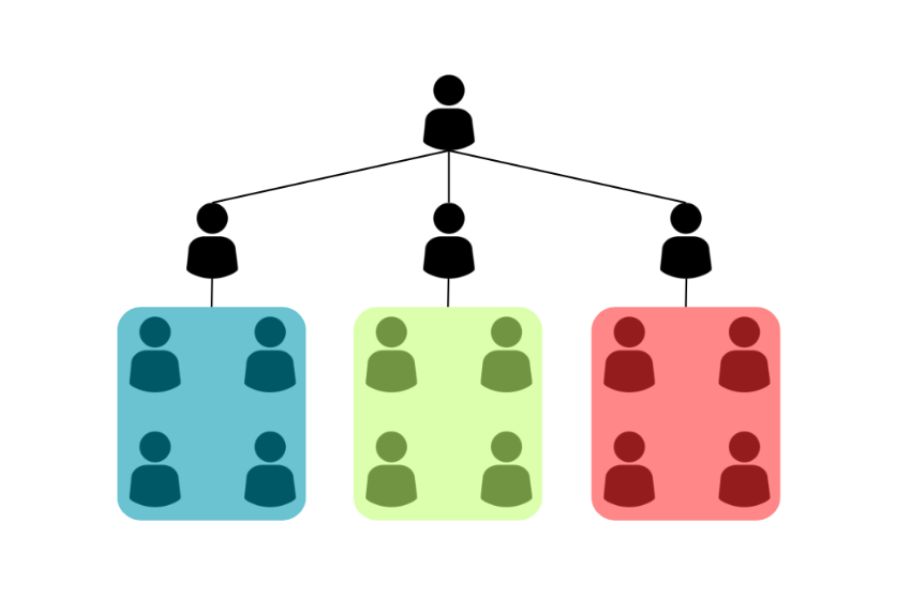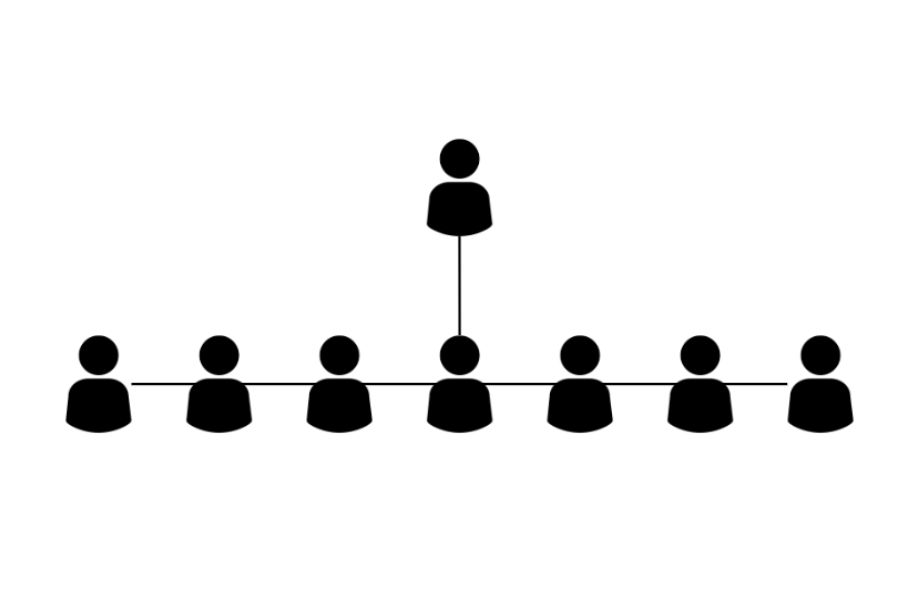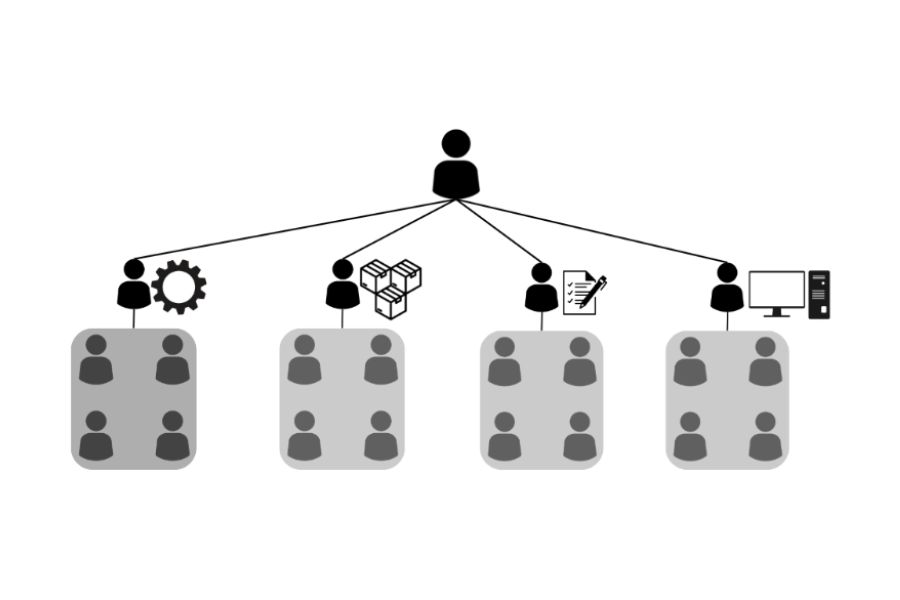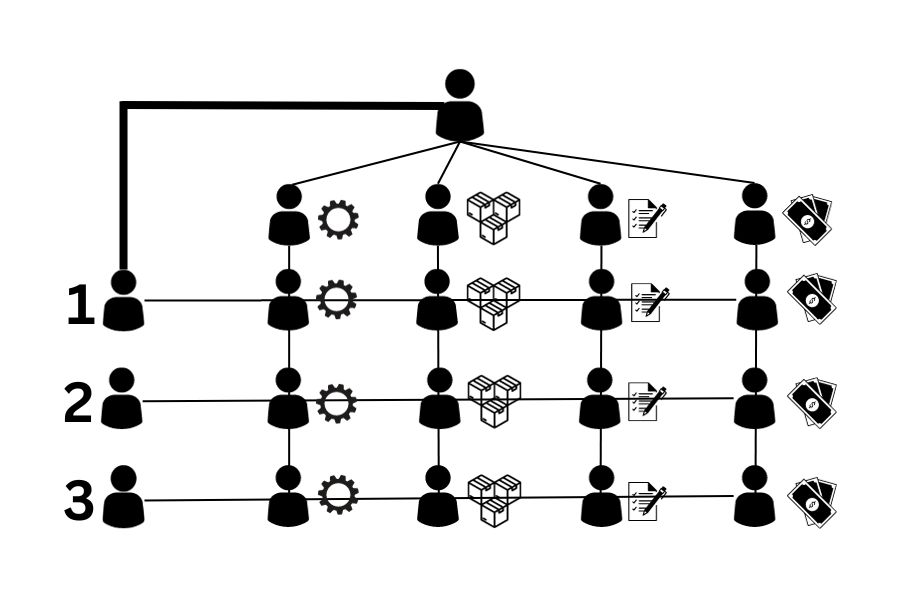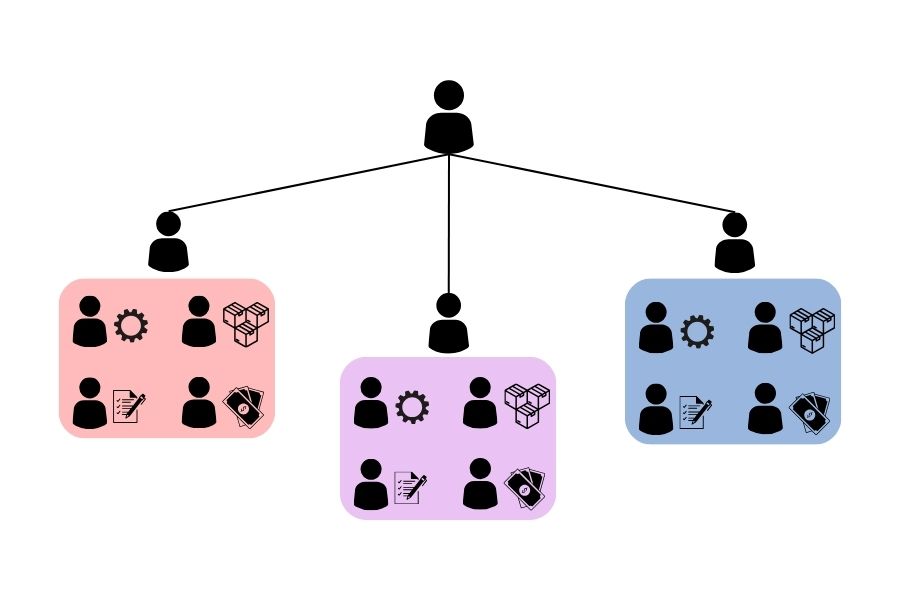One of the most important things to consider when setting up a business is the type of structure under which it will operate. This choice has far-reaching implications and will heavily influence the company’s operation and prospects. In this article, we’ll discuss the most common organizational structures, their benefits, and how each type can affect project management.
Types of Organizational Structures
We’ll start with the common types of organizational structures. Some of these overlap with one another, but each type has its own defining characteristics.
Hierarchical Organization Structure
A hierarchical organization structure (also known as a traditional or top-down structure) is a typical organizational structure used chiefly by large companies and corporations. This type of structure utilizes a centralized chain of command wherein authority flows from the top of the organization (CEO or similar) down to upper- and lower-level management. The most prominent example of this type of structure is Amazon.
A hierarchical structure has a few defining characteristics:
- Well-defined chain of command
- Centralized decision-making
- Formalized roles and responsibilities
- Vertical communication flow
- Project/Department prioritization
Functional Organizational Structure
A functional organizational structure is a common organizational arrangement where employees are grouped based on their specialized functions or areas of expertise. In this structure, each department or functional area is responsible for specific tasks and activities related to its function. For example, companies can be divided into accounting, human resources, production, quality assurance, etc. Each functional segment focuses solely on its intended function and any related activities.
Here are some of the defining characteristics and advantages of a functional organization structure:
- Independent departments or “silos”
- Clear reporting path
- Specialized functions
- Clear roles, responsibilities, and limitations
Want to master the impact of organizational structure in project management?
Contact Growth Hackers
Horizontal or Flat Organization Structure
A horizontal organizational structure, also known as a flat or decentralized structure, is a type of organizational arrangement that minimizes the number of levels of hierarchy between employees and top-level management. In a horizontal structure, there are relatively few layers of management, and decision-making is distributed more evenly across the organization. This greatly empowers individuals to make decisions based on specific circumstances and contexts. The tradeoff, however, comes from a less structured decision-making process.
Here are some features of a horizontal organizational structure:
- Limited management levels
- Decentralization
- Collaborative resource allocation
- Adaptable environment
Divisional Organizational Structure
A divisional organizational structure (also known as a “product-based” or “business unit” structure) is a type of organizational design where a company is divided into separate divisions or business units, each responsible for a specific product line, geographic area, demographic, or strategic function. This structure can intersect with a functional organizational structure.
- Clear roles and accountability
- Functional autonomy
- Better resource allocation
- Great for market focus (product, area, customer type, etc.)
Matrix Organizational Structure
A matrix organizational structure is a type of organizational design that combines elements of both functional and project-based structures. Employees have dual reporting relationships: they report both to a functional manager, typically based on their expertise or department, and a project manager for project-specific tasks. The dual reporting setup creates a matrix or grid-like structure (as shown above) aimed to leverage the benefits of both functional specialization and project focus.
Here are other benefits of a matrix organization:
- Better focus on product, project, customer group, or geographical requirements
- Dual reporting structure
- Flexible
Team-Based Organizational Structure
A team-based organizational structure, also known as a team-based structure or a team-oriented structure, is an organizational design that places a strong emphasis on cross-functional teams as the primary units of work and decision-making within the organization. Employees are organized into teams based on projects, processes, or specific goals, and these teams have a significant degree of autonomy and responsibility. They are somewhat similar to divisional organizations but on a smaller scale.
Team-based structures feature the following:
- Increased autonomy
- Tight focus on projects
- Better resource allocation
How Can Organizational Structure Impact Project Management?
The type of organizational structure directly impacts several core facets of business operations. Here, we’ll discuss the most heavily affected aspects:
Resource allocation
Businesses with multiple segments that employ functional or matrix structures may have issues with resource allocation. For example, a production company with a secondary logistics segment might have difficulty justifying the expense of improving the latter’s service. Innovations in fleet management technology, like everything else nowadays, are accelerating. One such decision may involve switching from wired to wireless dashcams for increased monitoring and real-time data access. However, since logistics is a secondary segment, upper management might not be willing to take away resources from other departments despite their inherent benefits. The stand-alone arrangement can also lead to increased competition between departments and a lack of cooperation. Resource allocation is more effective in divisional, matrix, horizontal, and team-based organizations.
Communication
The direction of communication depends on the type of structure the company employs. Hierarchical companies have vertical (top-down) and more formalized communication channels. Functional structures can use vertical and horizontal communication, while matrix organizations have a similar but perhaps more complex communication structure. These three types face several difficulties communication-wise in areas like filtration of information and duplication of reports.
Risk Management
Bigger corporations and companies with more centralized organizational structures may rely heavily on standardized risk assessment procedures. This can be a possible weakness in several ways. Standardized risk assessments will need to have a broad scope in order to cover likely scenarios. Such procedures can suffer from a lack of focus. Despite that, a centralized management team can limit the resources allocated to risk assessment.
Meanwhile, more decentralized organizations can create tailor-fitted assessments for different operations and contexts. However, this arrangement will require more resources and personnel, proportionally increasing with the size and scope of the project, function, or product.
Decision-making
The decision-making process heavily relies on the type of structure the company has and can typically be divided into two types: centralized and decentralized.
Centralized
Centralization concentrates the decision-making process on the top of the organizational stack. The limited number in upper management agree upon policies and company directives. These are handed down the chain. The lower-level management is responsible for disseminating information to the rest of the employees.
Centralization makes decision-making faster and more efficient since only the top management is involved. It also makes it cheaper, more efficient, and faster to implement. Furthermore, the limited number of participants allows for more consistency and accountability.
However, the setup also leads to distinct disadvantages. Employees far below the stack might not be considered when making decisions, which can lead to decreased company loyalty and high turnover rates. The ideal strategy would be to make feedback flow upward, too, but larger companies might find implementing such changes difficult or even impossible.
Another issue is the disconnect between making decisions and implementing them. Upper management may be susceptible to making goal-oriented decisions without considering the difficulty of implementing such changes.
Decentralized
Decentralization offers more flexibility when it comes to decision-making. At almost every management level, employees are empowered to make decisions based on different circumstances. This can also promote collaboration among different departments, teams, or divisions. The greater degree of autonomy can also promote more awareness of accountability since employees are held liable for their decisions.
However, decentralization also leads to losing control and inconsistency due to the number of decision-makers in play. It can also lead to resource management issues, increased interdepartmental conflicts, and duplication of tasks.
Elevate your project management – optimize organizational structure for success!
Considerations When Choosing an Organizational Structure
The overall effectiveness of project management ultimately depends on the people involved. Still, the type of organizational structure significantly impacts the prospects of success. Choosing a structure for your business depends on the following factors:
Business Strategy And Overall Goals
The company’s structure should be aligned with its short-term and long-term goals. Businesses aiming for rapid growth and development can benefit more from team-based, decentralized, and more flexible structures so that projects can be started and completed faster and more efficiently. Business strategies can change as time passes, which will require a more thorough analysis and can require changes in structure and project management guidelines.
Company Complexity Size
The size and complexity of the company matters in choosing the proper structure. Larger corporations can benefit from more complex hierarchies but may suffer from inefficiencies, especially with new projects. Smaller companies with simpler structures can be more nimble in such terms.
Resource Availability
All companies want to save money, but the fact is some structures are more resource-intensive than others. Structures should be aligned with the company’s available resources. Furthermore, inefficient resource management, including personnel, may lead to project slippage. Resource smoothing principles can be applied, but such practices are still highly dependent on the total available resources.
Company Culture and Type of Workforce
Promoting freedom in the workforce comes with the inherent promise of a more autonomous company structure. Such structures can lead to more efficient project management at a small to medium scale but can become an issue for larger companies.
Furthermore, different types of workforce may operate better under different structures. Millennials and Gen Z (younger workforce) prefer a more transparent and result-oriented structure. Project managers will also have to consider their employees’ skill levels. Additionally, project management style and structure should always be aligned with the company’s overall values and principles.
Final Words about How a Company’s Organizational Structure Impact Project Management
Project management is heavily impacted by the company’s structure — there is no question about that. However, the impact is not easily measured due to the interwoven nature of company structures, functional differences, influencing factors, and core company attributes. Despite the labels, each company operates uniquely, so the exact impact can only be measured by doing an in-depth analysis of project processes and results.
Growth Hackers offers outside the box growth hacking services helping businesses from all over the world grow. There is no fluff with Growth Hackers. We help entrepreneurs and business owners implement effective organizational structures in project management , increase their productivity, generate qualified leads, optimize their conversion rate, gather and analyze data analytics, acquire and retain users and increase sales. We go further than brand awareness and exposure. We make sure that the strategies we implement move the needle so your business grow, strive and succeed. If you too want your business to reach new heights, contact Growth Hackers today so we can discuss about your brand and create a custom growth plan for you. You’re just one click away to skyrocket your business.


